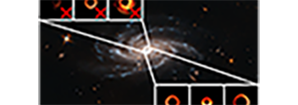Spotlight
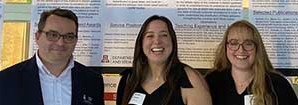
Congratulations to our 2023 College of Science Graduate Student Award Recipients from the Department of Astronomy
Please join me in congratulating our 2023 College of Science Graduate Student Award Recipients from the Department of Astronomy — a reception was hosted by the College on Monday of this week to honor all the award winners from the College and two of our students and their mentors/advisors were able to attend in person (photos of Samantha Scibelli and her advisor Yancy Shirley and Rachel Amaro and her advisor Daniel Apai are attached). Jiachuan Xu (advisor Tim Eifler) was on travel.
Congratulations to Jiachuan, Rachael, and Samantha!!! Some notes about their awards and why they were selected are below.
We will celebrate/recognize these award winners at the end of the Steward Observatory Internal Symposium this Friday. Each year there are three awards in each department for outstanding achievement/performance in the areas of research, teaching, and service.
Congrats to our three amazing students!
Buell Jannuzi, Xiaohui Fan, and Kaitlin Kratter
Jiachuan Xu: Research - Jiachuan is being recognized for his work on a new cosmological measurement technique known as Kinematic Lensing, which will utilize data from the upcoming Roman Space Telescope and other data sets.
Sam Scibelli: Teaching — Sam is being recognized for her outstanding work as a TA in ASTR 196 and 300B simultaneously. Sam took over in-class instruction for our undergraduate radiative processes classes due to an unexpected faculty illness.
Rachael Amaro: Service - Rachael is being recognized for her leadership as both a member of the initial Steward Observatory Diversity and Inclusiveness Committee, as well as one of the founders of the student led Steward Observatory Diversity, Equity, and Inclusion initiative.
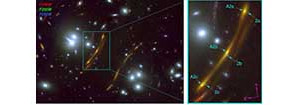
A Bright and Shiny Result from PEARLS
We report the discovery of a new transient in James Webb Space Telescope (JWST) NIRCam exposures of the massive galaxy cluster PLCK G165.7+67 (G165) taken as part of the Prime Extragalactic Areas for Reionization and Lensing Science (PEARLS) program (GTO-1176; PI: R. Windhorst). The source was not detected in previous Hubble Space Telescope images (Frye et al. 2019; Pascale et al. 2022).
Follow-up spectroscopy was accomplished using the Large Binocular Telescope (LBT) LUCI in a consortium-wide effort. The partners from Germany allocated the telescope time, the partners from Italy prepared, carried out, and reduced the spectroscopy, and the partners from UArizona directly supported the organization and observing activities. As a result of this grand effort, the redshift of the SN host was measured.
Additional imaging and spectroscopy have been carried out with JWST (DD-4446; PI: B. Frye). This one transient is detected in three different locations (a, b, and c) as a result of gravitational lensing by the foreground galaxy cluster G165. Our gravitational lensing model predicts that light from the transient arrived first in image “a,” followed by “c,” and then “b”. This transient, which we designate as "SN H0pe," is s Type Ia supernova that was classified as a result of analyzing the JWST observations.
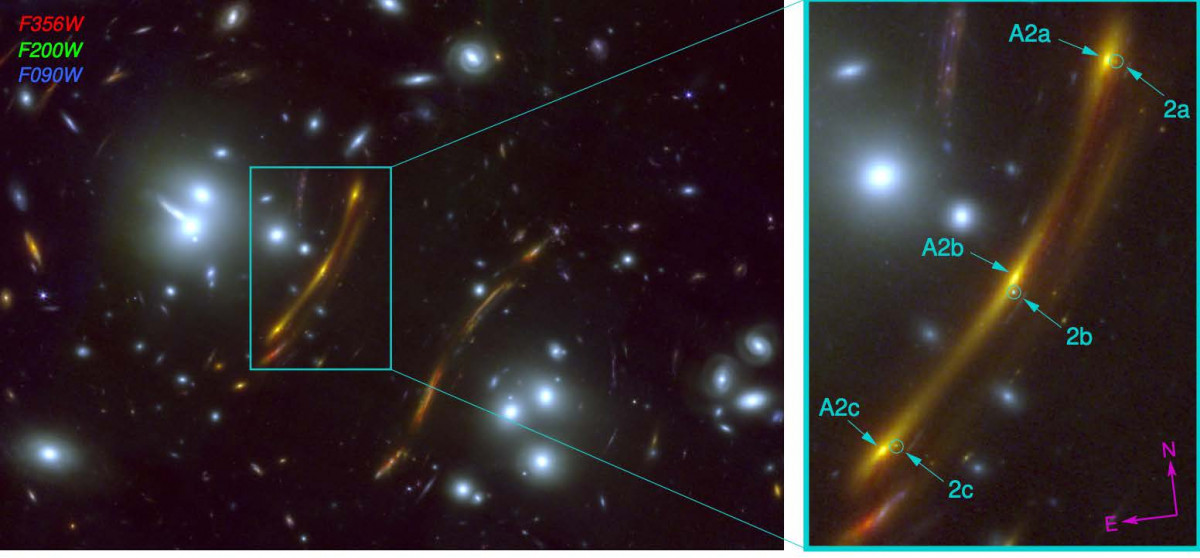
Figure caption: JWST/NIRCam color image in the central region of G165. {\it Right:} Closeup of the boxed region depicting the three images of the galaxy Arc 2, as labeled. The SN Ia candidate is circled. Note the parity flip between images 2c and 2b, and images 2b and 2a, as predicted by lensing theory. The SN Ia candidate appears in all three images.
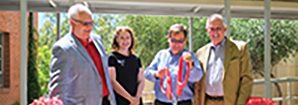
Celebrating 100-Years of Discovery!
Friends of Steward Observatory,
Our thanks to all of you who joined us this past Saturday to celebrate the 100th anniversary of the dedication of the “All American” 36-inch Telescope of Steward Observatory and our recommitment to the research, education, and outreach missions it generated. We hope you had as much fun as we did
The 36-inch, then a “Telescope of Huge Size,” according to the Arizona Daily Star, was built thanks to the philanthropic gift of $60,000 by Lavinia Steward to the University of Arizona. This enabled Andrew Ellicott Douglass, the first Director of Steward Observatory, to build the University’s first major research telescope. This was the start of our growth into a world-class Observatory and Department of Astronomy. It paved the way for other major research facilities at the University, and ushered in an era of transformational philanthropic giving to the University.
Today, in honor of our first century and the philanthropic legacy that shaped it, we ask you to consider making a donation that can stimulate a new century of growth that will make as much history as our first 100 years. Our goal is to secure 100 donations by the end of April 30. We are going to have a time capsule, to be opened on the 200th Anniversary of the dedication, that will have memorabilia from our celebration this past week as well as the names of the donors that participate in this mini-drive — so please consider joining Lavinia Steward among the long line of donors that have enabled us to explore the Universe together.
Sincerely,
Buell Jannuzi and Cathi Duncan
(On behalf of the Committee that Organized our Celebration of the Dedication of the 36-inch Telescope and rededication of Steward Observatory)
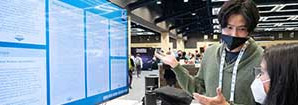
Congratulations to the AAS 241 Chambliss Student Award Winners
The latest Chambliss Astronomy Achievement Student Awards poster competition was a success, and we are happy to announce that four University of Arizona students have been awarded with this distinction! Lori Huseby, a graduate student in Planetary Sciences, was awarded with the Graduate Student Chambliss Award. The following graduate and undergraduate students received an Honorable Mention in the Chambliss competition; Jaren Ashcraft (Graduate Student, Optical Sciences), Michael Hardegree-Ullman (Research Technologist, Steward Observatory), Peter Hartman (Undergraduate Student, Astronomy), Wei Leong Tee (Graduate Student, Astronomy).
According to the American Astronomical Society, the Chambliss Astronomy Achievement Student Awards are given to recognize exemplary research by AAS Undergraduate and Graduate Student Members who present posters at meetings of the AAS. Awardees are honored with a Chambliss medal or, in the case of honorable mention, a certificate.
Congratulations to those students!
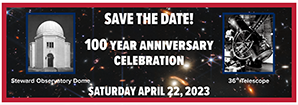
Save the Date! 100 Year Anniversary Celebration
On April 22, 2023 we will re-dedicate the Steward Observatory Dome and 36” telescope which started the 100 year journey to today. We thank Mrs. Lavina Steward for her generous $60,000 donation to the University of Arizona to build the dome and the “first All-American made reflecting telescope”, both are still in use today.
At the dedication in 1923, Dr. Andrew Ellicott Douglass said the following:
“A dedication like this symbolizes the completion of a material part. But a dedication is dual, in being apart material and part spiritual. The material part is the building of brick and steel and glass which you see; the spiritual par is the living human force which enters this Observatory and makes it live. In this ceremony we dedicate ourselves to the perpetuation of this human force, which is nothing less than the soul residing in this physical structure. I want this Steward Observatory to live, and in living it must grow, and in growing it must produce results. Its use for classes is fine; its use for the public is fine; but it will not live without scientific results. That means we must have scientific men [and women] to keep it busy. From time to time, further equipment should be added in order to enlarge human knowledge and suitable publications must present to the world the knowledge acquired here.”
As we celebrate this 100-year milestone, we will honor the great astronomers who have come before us and congratulate the astronomers of today for they continue the spirit of Steward Observatory and will pass this on to the next-generation.
In preparation for the 100th anniversary of the dedication we have refurbished the first floor of the dome. It is now a combination museum, and small (but very deluxe) conference/class room. Initial seed money was provided by Michael Chriss. From there, we added an accessible entrance and completely redecorated the interior. There is a display highlighting E. A. Douglass and the development of the telescope, and we rescued display cabinets originally built for Edwin Carpenter to display artifacts from the history of the observatory. Two large display screens act as programmable displays, and there is a touchscreen kiosk linking to the major observatory activities.
We hope you will join us for this exciting event!
For more information contact: Cathi Duncan, cduncanf@arizona.edu or 520-621-1320
Pages

For Public
Public events include our Monday Night Lecture Series, world-reknowned Astronomy Camp and Mt Lemmon Sky Center.

For Students
A good place to start if you want to become an undergrad major or grad student, or need to find our schedule of classes.

For Scientists
Find telescopes and instruments, telescope time applications, staff and mountain contacts, and faculty and staff scientific interests.



